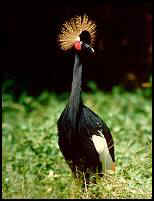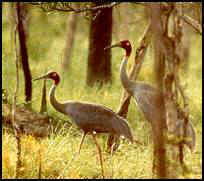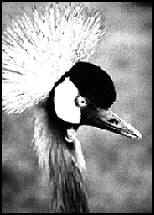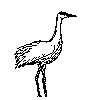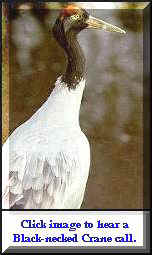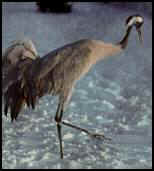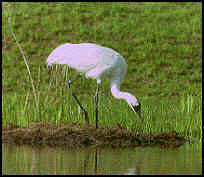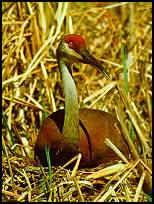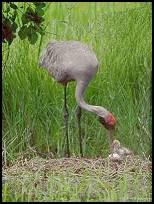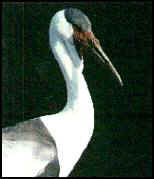|
www.childrenoftheearth.org |
|||
|
|
|
Let's Learn About Cranes ! |
|||
|
Cranes are large, beautiful, graceful, long-lived birds which have inspired awe among people for millennia. For many cultures, particularly in the Orient, cranes have a deep cultural and mythological significance. For conservation projects the beautiful and charismatic cranes provide the incentive to conserve wetlands and grasslands upon which many other less charismatic, but equally important species, also depend. The crane family is also widespread, existing on five of the seven continents. (Only Antarctica and South America do not have cranes.) Preserving cranes and their habitat requires a careful, disciplined, and holistic approach to their conservation. Of the 15 species of cranes, eleven are vulnerable to extinction, making cranes one of the most threatened families of birds in the world. The two species of cranes that call North America home, the Sandhill and Whooping Cranes, demonstrate the range of population sizes. The adaptable Sandhills are the most numerous of all cranes with an approximate population of over 500,000 birds. Whooping Cranes, however, are the rarest of all cranes with a total population of approximately 500 birds. Other similar-looking birds include herons, storks, and spoonbills, but they are not closely related to cranes. Rather, these different families of wading birds have evolved similar adaptations to living in wetlands. In North America, coots and rails are the crane's closest relatives.
|
|
||
Individual and Social BehaviorCranes pursue small prey, and sometimes each other, by running. A running crane takes one to three steps per second and may use its wings for balance and to gain speed. While a running crane looks awkward, they can easily outrun humans. Cranes do not have webbed feet, but they can swim, although adult birds usually avoid deeper water unless necessary. Chicks are good swimmers and may leave the nest to follow the parents through the wetlands, sometimes within a few hours of hatching.
|
|
||
|
Feathers give cranes both the ability to fly and to regulate their temperature. Made of
the same material as human fingernails, feathers require constant attention. A crane
preens by nibbling the base of a feather and then drawing it through the bill. Preening
straightens and closes repairable gaps in the feather. When preening, cranes may apply oil
to the feathers obtained from a special gland located on top of the tail. Contrary to
previous belief, the oil does not serve as waterproofing, but helps condition the feathers
and may also have fungicidal and antibacterial properties. Prolonged preening sessions
follow water or dust bathing. While cranes spend a great deal of time caring for their feathers, the feathers still wear out and are replaced during a seasonal molt. Many crane species are flightless during the molt, which usually occurs during late spring when the adults are raising their chicks. It is not unusual for flightless cranes to stay near heavier cover until they and their young can fly. Cranes, such as the crowned cranes, living in predator-dense areas lose their feathers over a longer period of time and never become flightless. Sandhill Cranes and Eurasian Cranes "paint" themselves by preening mud into their feathers prior to the breeding season. Painting acts as camouflage, helping the cranes hide amid the brown vegetation of an early spring marsh. Siberian Cranes also paint themselves, but only at the base of the neck. This "makeup" indicates that the birds are in their prime and ready to breed.
|
|
||
| Cranes are aggressive birds. When fighting, they leap into the air to rake opponents with their sharp claws or stab at an opponent with their bill. This continues until one bird runs or flies away, sometimes closely pursued by the victorious bird. Fighting is dangerous to both participants, however, so cranes use a complex system of threat behaviors allowing rivals to avoid fighting. Communication includes both physical postures and vocalizations. Ruffle, drop-wing, and crouch threats indicate low-, mid-, and high-intensity aggression levels respectively, so many aggressive encounters are resolved before fighting becomes necessary. (The animated picture on the top shows a crane performing a ruffle threat; the picture on the bottom show a crane performing a crouch threat.) Most crane species also will flash the bright red patch on top of their heads to an opponent or predator to indicate growing excitement. |
|
||
|
|||
Flight and MigrationCranes typically run into the wind to achieve the lift necessary for flight, but if alarmed a crane can spring directly into flight. Cranes may fly as fast as 52 m.p.h. during level, flapping flight, but prefer to soar, especially during migration. When soaring in thermals (updrafts of warm air), cranes will circle until they reach a desired altitude, usually between 3,000 and 5,000 feet. Once the appropriate altitude is reached, the cranes leave the thermal and glide forward, slowly losing altitude. They then find another thermal and repeat the procedure. While slower than level flapping flight, soaring conserves energy. Cranes prefer to migrate at altitudes of less than 5,000 feet, but some species are forced to fly much higher. In North America, mountain ranges run north and south and birds migrate parallel to them. In Asia and Europe, however, mountain ranges, such as the Himalayas and Pyrenees, generally run east and west forcing cranes and other birds to negotiate mountain passes as high as 20,000 feet. Daily flights may range from a few miles in bad weather to several hundred miles if suitable stopover points are unavailable. Cranes often migrate in large flocks when conditions are favorable. At night, migrating cranes often roost at "staging areas" in water that is 4-8" deep. Staging areas usually consist of safe roosting sites in shallow marshes or on submerged river sandbars. There are usually good foraging areas within a short flight of the roosting sites and cranes may remain at staging areas for several weeks as they regain energy and rest. Staging areas of some species are traditional resting spots that have been used for hundreds and possibly thousands of years. Examples of staging areas used by Sandhills include the Platte River (Nebraska), Jasper-Pulaski State Wildlife Area (Indiana), and the Sandhill Wildlife Demonstration Area (Wisconsin). |
|
||
|
|
||
Nesting and ReproductionCranes are territorial during the breeding season, with each pair defending an area in which it will attempt to raise young. Sandhills may nest in areas of less than three acres, but the average territory size is larger than 50 acres. Larger crane species typically have larger territories. Territories will tend to be smaller in areas where there is abundant food, good nesting sites, and high crane population densities. Most crane species nest in shallow marshes, but Demoiselle and Blue Cranes build scant nests in dry prairie or savanna, although usually within a few hundred yards of a water source. In deeper marshes, cranes build massive nests from nearby wetland plants. Often a "moat" forms around the nest because the cranes use so many of the nearby plants for constructing the nest. Nests may be five to six feet across and tall enough that the water does not reach the eggs. Nest construction takes from one to seven days. Once the female lays the eggs, the
pair shares incubation duties "exchanging" the incubating responsibilities about
every two hours during the day, although towards the end of the incubation the nest is
exchanged more often. This gives both birds a chance to feed and exercise. At night, it is
thought the female does the bulk of the incubation, while the male stands guard nearby. |
|
||
| The time of hatching
coincides with the emergence of insects on which the young will feed. Timing of the hatch
is particularly important for migratory cranes so the young can grow and gain the size and
strength necessary to migrate before winter sets in. Timing is less important with
non-migratory cranes which live closer to the tropics. Both parents feed the chicks, but the male usually feeds the chicks first. The newly-hatched chick may be offered small pieces of the egg shell or the female may consume the shell, perhaps to replenish the calcium used from her body to coat the eggs. Often the shell is simply carried away from the nest and discarded as not to attract predators. Both parents brood the young birds to protect them from both cold and precipitation. Brooding also helps warm the chick during the first few days after hatching when it cannot control its own body temperature. The family leaves the nest after the second chick hatches, but may return to the nest for several evenings to brood the chicks during the cool of the night. |
|
||
Population DynamicsCranes have low reproductive capabilities making it difficult for them to replace losses due to hunting, natural and human-caused disasters, predation, accidents, and disease. Cranes do not begin nesting until they are 3-7 years old and then they generally lay just two eggs each year. Of the two eggs, usually only one chick will survive. Cranes, however, may live for 25-30 years in the wild and the one chick they raise each year will likely fledge and join the migratory flock. The survival strategy of cranes, therefore, is the opposite of animals like rabbits or mice, which have short lives and high reproductive rates. Recruitment rates (the number of young in the flock each fall) varies from species to species, but ranges from about 10-14% for Sandhill Cranes.
|
|
||
Legal ProtectionsCranes have both formal and informal protections around the world. Informal protections may include religious or cultural protections. Formal protections include state or local laws against the direct taking of individuals, and may, or may not, include protections for habitat. Laws against direct taking are often poorly enforced. In North America, hunting of cranes is regulated by state, provincial and international treaty. The Migratory Bird Acts of 1916 (between the U.S. and Canada) and of 1936 (between the U.S. and Mexico) regulates hunting of migratory species. It is illegal under these acts to take or possess regulated species or their parts (including eggs and feathers) unless there is a legal hunting season on that species, or if the person possessing the bird has been granted a permit for scientific purposes or for captive propagation. The U.S. also has the Endangered Species Act which protects rare species and its habitat, especially areas designated as critical habitat. - The International Crane Foundation When your done click here to play a game to test your knowledge of cranes.
(Population information was updated February, 2008)
|
|
||
|
Used with
permission from the International Crane Foundation |
|||
